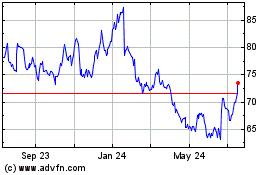Pivotal Data Demonstrating Efficacy of Darusentan in Treating Resistant Hypertension Published in The Lancet
September 13 2009 - 6:47PM
Business Wire
Gilead Sciences, Inc. (Nasdaq:GILD) today announced the
publication of data from DAR-311 (DORADO), a Phase III clinical
trial evaluating the company’s once-daily oral endothelin receptor
antagonist (ERA) darusentan as an add-on treatment for resistant
hypertension, defined as the failure to achieve blood pressure goal
while adhering to full doses of an appropriate three (or more) drug
antihypertensive regimen that includes a diuretic. The results of
the DAR-311 study, published online and in an upcoming edition of
The Lancet, show that darusentan was effective at reducing trough
sitting and mean 24-hour systolic blood pressure (SBP) and
diastolic blood pressure (DBP) after 14 weeks of treatment in
patients with resistant hypertension.
DAR-311 is an international Phase III double-blind,
placebo-controlled parallel group trial, in which 379 patients were
randomized to receive once-daily doses of darusentan 50 mg (n=81),
100 mg (n=81), 300 mg (n=85) or placebo (n=132) for up to 14 weeks
as an add-on to existing antihypertensive regimens. The co-primary
efficacy endpoints were change from baseline to week 14 in trough
sitting SBP and DBP. Secondary endpoints included change from
baseline in mean 24-hour SBP and DBP and percent of patients
reaching SBP goal. The most common patient-reported adverse events
were edema and/or fluid retention, dizziness, headache and fatigue.
Results from this study were presented at the American Society of
Hypertension, Inc. Twenty-Fourth Annual Scientific Meeting and
Exposition (ASH 2009) in May 2009.
“The addition of darusentan with optimized diuretic therapy has
promise as a new strategy for treating patients with resistant
hypertension, a condition for which no standard of care currently
exists,” said Michael A. Weber, MD, Professor of Medicine at the
SUNY Downstate Medical College of Medicine, Brooklyn, New York and
lead study author. “These findings are important because patients
with resistant hypertension are likely to be at increased risk of
cardiovascular events including stroke, myocardial infarction and
renal failure due to long-standing history of inadequately
controlled hypertension, typically in conjunction with other risk
factors like obesity, diabetes and chronic kidney disease.”
DAR-311 Results
Baseline Demographics
Baseline demographic and clinical characteristics were
comparable across treatment groups. The mean patient age was 62
years old. There were nearly equal numbers of women and men in the
study and 20 percent of patients were black. The mean body mass
index (BMI) was 32 kg/m2, an indication of obesity. Forty percent
of patients were diabetic and 25 percent of patients had chronic
kidney disease (CKD). At baseline, 58 percent of patients were on
four or more antihypertensive medications. Mean baseline trough
sitting SBP and DBP measures were 151 mm Hg and 86 mm Hg,
respectively.
Primary Endpoint Results
Each of the three darusentan groups experienced statistically
significant reductions (versus placebo) in trough sitting SBP and
DBP. The mean reductions in SBP/DBP were 17/10 mm Hg with
darusentan 50 mg, 18/10 mm Hg with darusentan 100 mg, 18/11 mm Hg
with darusentan 300 mg and 9/5 mm Hg with placebo (p
Gilead Sciences (NASDAQ:GILD)
Historical Stock Chart
From Jun 2024 to Jul 2024

Gilead Sciences (NASDAQ:GILD)
Historical Stock Chart
From Jul 2023 to Jul 2024
